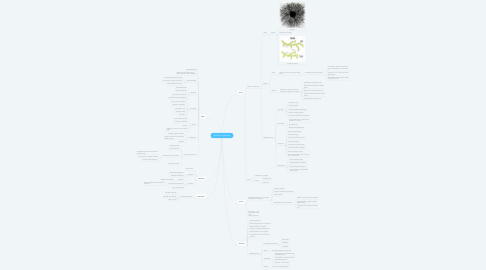
1. Fungi
1.1. Molds and Fleshy Fungi
1.1.1. Thallus
1.1.1.1. Hyphae
1.1.1.1.1. Mycellium
1.1.1.1.2. Septate-have cross walls
1.1.1.1.3. Coenocytic-no septa
1.1.2. Division
1.1.2.1. Sexual
1.1.2.1.1. Fusion of nuclei from two opposite mating strains
1.1.2.2. Asexual
1.1.2.2.1. Produced via mitosis and cell division; formed by the hyphae of one organism
1.1.3. Medically Important
1.1.3.1. Zygomycota
1.1.3.1.1. Conjugation fungi
1.1.3.1.2. Coenocytic hyphae
1.1.3.1.3. Produced asexually: sporangiospore
1.1.3.1.4. Produced sexually: zygospore
1.1.3.1.5. Forms when nuclei of two similar cells fuse
1.1.3.2. Microsporidia
1.1.3.2.1. No sexual reproduction is observed, but probably occurs in a host
1.1.3.2.2. No mitochondria
1.1.3.2.3. Obligate intracellular parasites
1.1.3.3. Ascomycota
1.1.3.3.1. Sac fungi; septate hyphae
1.1.3.3.2. Teleomorphic fungi
1.1.3.3.3. Produce sexual and asexual spores
1.1.3.3.4. Some are anamorphic
1.1.3.3.5. Lost ability to sexually reproduce
1.1.3.3.6. Produced asexually: conidiospore
1.1.3.3.7. Produced sexually: ascospore
1.1.3.3.8. Nuclei morphologically similar or dissimilar fuse in a saclike ascus
1.1.3.4. Basidiomycota
1.1.3.4.1. Club fungi; septate hyphae
1.1.3.4.2. Produced asexually: conidiospores
1.1.3.4.3. Produced sexually: basidiospores
1.1.3.4.4. Formed externally on a base pedestal called a basidium
1.2. Yeasts
1.2.1. nonfilamentous, unicellular
1.2.2. Division
1.2.2.1. budding-uneven
1.2.2.2. fission-even
2. Lichens
2.1. Mutualistic combination of a green alga (or cyanobacterium) and fungus
2.1.1. Fruticose—fingerlike
2.1.2. Crustose—encrusted on the substratum
2.1.3. Foliose—leaflike
2.1.4. Thallus (body) of lichens are made of:
2.1.4.1. Medulla—hyphae grown around algal cells
2.1.4.2. Rhizines (holdfasts)—hyphae projections below the body
2.1.4.3. Cortex—protective coating over the algal layer
2.2. Important for: Dyes Antimicrobial (Usnea) Litmus Food for herbivores
3. Algae
3.1. Mostly Water Based
3.2. Thallus: body of multicellular algae Consists of holdfasts, stipes, and blades
3.3. Brown algae (kelp)
3.3.1. Cellulose and alginic acid cell walls
3.3.2. Produce algin—thickener used in foods
3.3.3. Multicellular and macroscopic
3.4. Red algae
3.4.1. Have branched thalli
3.4.2. Most are multicellular
3.4.3. Some produce a lethal toxin
3.4.4. Harvested for agar and carrageenan
3.5. Green algae
3.5.1. Gave rise to terrestrial plants
3.5.2. Unicellular or multicellular
3.5.3. Chlorophyll a and b
3.5.4. Cellulose cell walls
3.5.5. Store starch
3.6. Diatoms
3.6.1. Pectin and silica cell walls
3.6.2. Unicellular or filamentous
3.6.3. Store oil
3.6.4. Produce domoic acid—cause neurological disease
3.7. Dinoflagellates
3.7.1. Cellulose in plasma membrane
3.7.2. Neurotoxins (saxitoxins) cause paralytic shellfish poisoning
3.7.3. Unicellular
3.8. Oomycota (water molds)
3.8.1. Cellulose cell walls
3.8.2. Produce zoospores
3.8.3. Decomposers and plant parasites
3.8.3.1. Phytophthora infestans was responsible for Irish potato blight
3.8.3.2. P. ramorum causes "sudden oak death"
3.8.3.3. P. cinnamoni infects Eucalyptus
3.8.4. Chemoheterotrophic
4. Helminths
4.1. Parasitic worms
4.2. Two phyla:
4.2.1. Platyhelminthes (flatworms)
4.2.2. Nematoda (roundworms)
4.3. Replication
4.3.1. Dioecious
4.3.1.1. Separate male and female
4.3.2. Monoecious (hermaphroditic)
4.3.2.1. Male and female reproductive systems in one animal
4.3.3. Egg → larva(e) → adult
5. Arthropods
5.1. Representative classes:
5.1.1. Arachnida—eight legs
5.1.2. Crustacea—four antennae
5.1.3. Insecta—six legs
6. Protozoa
6.1. unicellular eukaryotes
6.2. Feeding and growing form is a trophozoite
6.3. Asexual reproduction is by fission, budding, or schizogony (multiple fission)
6.4. Sexual reproduction is by conjugation
6.5. Some produce a cyst to survive adverse conditions
6.6. Medically Important
6.6.1. Feeding grooves (Excavata)
6.6.1.1. Diplomonads
6.6.1.2. Euglenozoa
6.6.1.3. Parabasalids
6.6.2. Ciliates
6.6.2.1. Move by cilia arranged in precise rows
6.6.3. Apicomplexa
6.6.3.1. Toxoplasma gondii—transmitted by cats; causes fetal infections
6.6.3.2. Cryptosporidium—transmitted via feces; causes waterborne illness
6.6.3.3. Plasmodium—causes malaria
6.6.4. Amebae
6.6.4.1. Move by extending pseudopods
